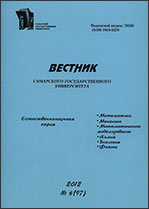|
This article is cited in 2 scientific papers (total in 2 papers)
Mechanics
Reference shape of bodies with finite incompatible deformations
S. A. Lycheva, K. G. Koifmanb
a Ishlinsky Institute for Problems in Mechanics, Russian Academy of Sciences, Moscow, Russian Federation
b Bauman Moscow State Technical University, Moscow, Russian Federation
(published under the terms of the Creative Commons Attribution 4.0 International License)
Abstract:
The work develops differential-geometric methods for modeling of finite incompatible deformations of hyperelastic solids. Deformation incompatibility can be caused, for example, by inhomogeneous temperature fields and distributed defects. As a result, residual stresses and distortion of geometric shape of the body occur. These factors determine the critical parameters of modern high-precision technologies, in particular, in additive manufacturing technologies. In this regard, the development of methods for their quantitative description is an urgent problem of modern solid mechanics.
The application of methods of differential geometry is based on the representation of a body as a smooth manifold equipped with a metric and a non-Euclidean connection. This approach allows one to interpret the body as a global stress-free shape and to formulate the physical response and material balance equations with respect to this shape. Within the framework of the geometric method, deformations are characterized by embeddings of non-Euclidean shape into physical space, which is still considered to be Euclidean. Measures of incompatibility are identified with the invariants of the affine connection, namely, torsion, curvature, and nonmetricity, and the connection itself is determined by the type of physical process.
Keywords:
hyperelasticity, incompatible deformations, residual stresses, non-Euclidean geometry, material metric, material connection, torsion, curvature, nonmetricity, moving frame method.
Received: 30.09.2022
Revised: 16.11.2022
Accepted: 05.12.2022
Citation:
S. A. Lychev, K. G. Koifman, “Reference shape of bodies with finite incompatible deformations”, Vestnik SamU. Estestvenno-Nauchnaya Ser., 28:3-4 (2022), 53–87
Linking options:
https://www.mathnet.ru/eng/vsgu689 https://www.mathnet.ru/eng/vsgu/v28/i3/p53
|

| Statistics & downloads: |
| Abstract page: | 61 | | Full-text PDF : | 29 | | References: | 22 |
|




 Contact us:
Contact us: Terms of Use
Terms of Use
 Registration to the website
Registration to the website Logotypes
Logotypes









 Citation in format
Citation in format 
